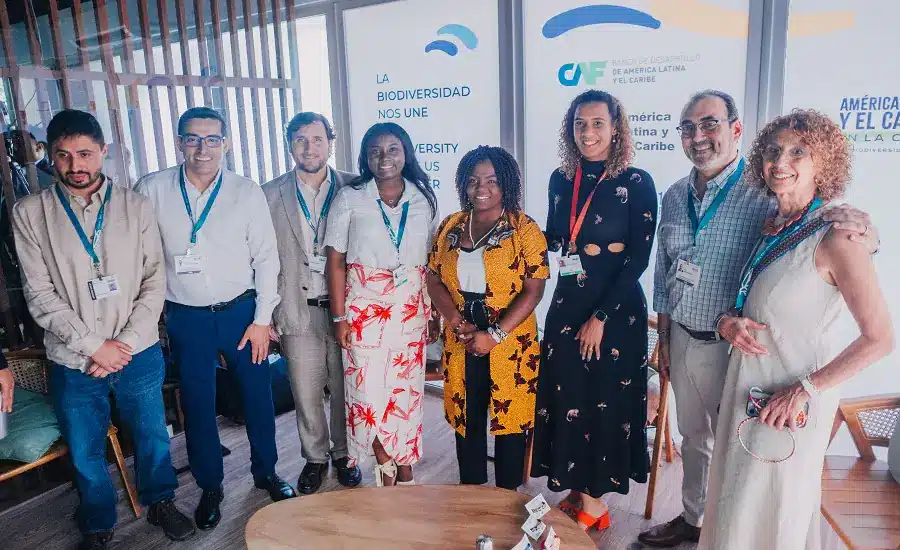COP16: CAF Announces a USD 300 Million Program to Protect Latin America and the Caribbean’s Biodiversity
At the opening of the Latin America and Caribbean Pavilion at COP16 in Cali, CAF – Development Bank of Latin America and the Caribbean – announced a USD 300 million program to conserve and restore the region’s key strategic ecosystems in Latin America and the Caribbean. The project will also mobilse additional financial resources and enhance collaboration between local governments, the private sector, and civil society.
The program’s launch, attended by Colombia’s Vice President Francia Márquez, Brazil’s Minister of Racial Equality Anielle Franco, and CAF’s Executive President Sergio Díaz-Granados, took place at the Latin America and Caribbean Pavilion at COP16, titled #BiodiversityUnitesUs. This space is open to governments, private sector representatives, scientific institutions, NGOs, local communities, and Indigenous and Afro-descendant peoples from across the region.
“The eyes of the region and the world are on Cali. The agreements we reach, the partnerships we build, and the actions we take will shape the future. This USD 300 million is just the beginning, as we will offer a tool for identifying high-quality projects to channel grant and financing resources, encouraging new investments to protect biodiversity in our countries,” said CAF’s Executive President, Sergio Díaz-Granados.
In her remarks, Francia Márquez said, “From here, we send a message of peace, that long-desired peace. We, the people from this Pacific region, are honoured to welcome you. And it’s not just about the species; it’s also about the people—people who, despite having been on their knees, rise up and walk. This is also a region that has suffered from armed conflict and disproportionate violence.”
Anielle Franco, in turn, highlighted the Afro-descendant Peoples of the Americas program, a partnership built with Afro-rural communities to implement concrete actions to improve the quality of life for our peoples, acknowledging the historical challenges and socio-environmental vulnerabilities faced by Afro-descendant communities.
“Many people often don’t understand the purpose of the documents we sign, such as protocols of intent and memorandums of understanding. But those were seeds we were planting, and today, we see them flourishing. Brazil and Colombia are implementing this regional program to tackle racial and socio-environmental inequalities affecting these historically excluded and marginalised communities,” Franco said.
As a precedent for this fund, in August 2024, CAF signed a USD 50 million credit line with BBVA Colombia to finance local credit operations involving conservation, restoration, regeneration, and sustainable use of strategic ecosystems in Colombia.
More recently, in El Salvador, CAF participated alongside other partners in the largest debt-for-nature swap in history for the conservation of watersheds, particularly in the Lempa River region. The repurchase of more than USD 1 billion in bonds will fund conservation efforts, water security, and ecosystem restoration.
Latin America and Caribbean Pavilion at COP16
The Latin America and Caribbean Pavilion at COP16, organised by CAF, will highlight the region’s potential to lead biodiversity conservation efforts, drive climate action with its lush ecosystems, recognise the value of ancestral knowledge, and promote the development of the blue economy.
During the two weeks of COP16, the pavilion will focus on key environmental issues affecting the region, including:
- Strategic Ecosystems and Innovative Financing: The major ecosystems of Latin America and the Caribbean transcend borders, and their preservation requires greater regional integration and a comprehensive environmental vision. Protecting the Cerrado in Brazil ensures sustainability in the Tumbes-Chocó-Magdalena region. The sustainability of the Mesoamerican Biological Corridor is tied to the Andes.
- Science and Inclusion: The pavilion will also address the role of science in fostering positive biodiversity outcomes. Collaboration between science, society, and public policy is essential to addressing the biodiversity crisis.
- Inclusion of Indigenous and Afro-descendant Communities: These communities are at the heart of our actions and symbolise what we want this space to represent—a place of encounter and integration, where all voices are heard in the search for solutions.
- Sustainable Cities and Local Government Solutions: More than a dozen partners will host events here, showcasing the immense value of cooperation.





